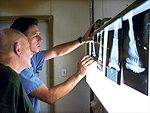Advertise Follow Us
Articles by Heather Smith Thomas
Therapeutic Shoeing
Proper Planning, Teamwork Play Big Role
Advancements in materials and techniques offer hope for serious injuries, but place premium on continuing hoof-care education
Read More
Therapeutic Shoeing
A Place for Veterinarian-Farrier Teamwork
Don’t be afraid to ask for help when you’re providing the hoof care an injured horse needs for recovery
Read More
Hoof-Coating Roundup
Manufacturers and distributors discuss the composition, applications and advantages of their products
Read More
Using Diagnostic Imaging to Pinpoint Foot Problems
The vital information that technology can provide is another reason for farriers to work closely with veterinarians
Read More
Conformation's Influence on Motion
Understanding the subtle details of a horse’s conformation will best prepare you for effective trimming and shoeing
Read More
Fly, Insect Control A Must For Farrier Safety
Knowledge of pest behavior helps in repellent choice, application
Read More
New Track Surfaces Present Challenges To Platers
Jury still out on the best way to shoe for synthetic tracks
Read More
Dealing with Sheared Heels
The causes of this common problem may be more complex than they appear on the surface
Read More
Helping a Racehorse to the Winner's Circle
Expert farriers share trimming and shoeing techniques they’ve used to help Thoroughbreds, Quarter Horses and steeplechasers reach peak performance
Read More












